Some might consider the Pale Morning Dun to be the mayfly they think of when they think of mayflies. It’s not particularly flashy. It doesn’t get overly large. It’s honestly not much to look at, with its thin, yellow hue. But the PMD might be the most important mayfly there is when it comes to trout fishing. In all its forms, from its nymphal larvae to its loud-and-proud dun, the PMD is a widespread mayfly that very likely makes up one of the largest percentages of a trout’s diet on any number of freestone and tailwater rivers in the United States and beyond.
From the gravel of the Delaware River in the East to the substrate of the Deschutes in the West, PMDs and their closely-related first cousins, the Sulfur and the Pale Evening Dun, mark the onset of summer fishing. They do very well in cold, aerated waters, which is why they are particularly prolific in big, sweeping tailwaters, like the South Fork of the Snake in Idaho, and the Missouri in central Montana.
These are the flies that often hatch in clouds. They’re so prolific that anglers must resort to sheer creativity to get a trout to eat an imitation during the height of a hatch – sizing up or sizing down is often a go-to choice when the numbers of naturals on the water require anglers to try and make their offering stand out. Others try a cripple pattern – a PMD that's tied to look like it’s stuck in the surface film. Still others abandon the pattern together and go with something completely different, like a caddis pattern or even a trico or a baetis.
Whatever it takes, right?
During the peak of the PMD emergence, sometime around mid-June, depending on the river, they are often so numerous that they have lasting effects wherever they hatch. Not only do trout dial in on the duns — those proud and elegant, big-wing adults that sail gracefully down the river with nary a dent in the surface film — but they key in on the emerging mayflies prior to the actual pop and again on the spent spinners as they drift flat and flaccid over cold, clear trout water.
The PMD is the ubiquitous mayfly — its flat and pale color is unremarkable, but its prolific nature can’t be ignored. And, to the eye of the dry-fly angler, the PMD (or the PED or the sulfur) is really quite lovely. It’s the harbinger of summer — the first mayfly hatch that portends good things to come.
Match it if you can
Venture into any reputable fly shop on the banks of any iconic trout river and you'll likely see a dozen different PMD dry-fly patterns tied to inspire an eat. Some are classics, like the simply tied dun or the parachute version. Others are more impressionistic – a nod to the presumed need to offer something different, especially when the bugs are really going off.
And, during the hatch, anglers desperate to find the right pattern, the secret sauce, load fly boxes with every possible imitation. Cripples and spinners, waifish CDC patterns and hair-wing dries show up in boxes held closely to the chest. Even soft-hackle versions of the bug show up, and, truthfully, they can be incredibly effective just as a hatch is starting.
But no one pattern seems to consistently do the trick. Some work better than others, but ask any guide on any big, cold trout river that boasts a PMD Hatch (or a Sulfur hatch or or a PED hatch). No one single pattern works every time. There is no “silver bullet.”
So the search continues.
Try, try and try again
And that’s the predicament Craig DeMark and I found ourselves in on the Missouri River last week. It had been a blustery morning, although the occasional wind gust was nothing compared to the solid 30-mph, in-your-face gale we dealt with the day before. We rowed the iconic canyon section that day, and Craig and I spent a good 90 minutes on a single fish — a behemoth, to be sure — only to admit defeat and row out so we could be back at his place for dinner.
The wind was problematic, not because it hampered the cast, per se. The cast was tight. The fish, which Craig estimated to be two feet long, was a regular eater, and, from the minute we started casting to it, the big brown was gobbling down PMD spinners. But the leader and the tippet (and the fly) … that’s another story. And, frankly, that’s another story for another day.
But this day was cool and cloudy with bouts of rain, and the PMDs had been threatening to hatch all day long. Finally, just before lunch, the hatch started to pick up momentum. And, to his credit, Craig spotted a nice, fat brown rising consistently just above a section of froggy water. He positioned his boat, and I started casting, starting with the obvious — a simple PMD dun pattern.
I got a few good drifts, but the brown mocked me, rising to something totally different not inches away from my imitation mayfly. So we sized up and drifted a bigger dun. Nothing. Then we sized down and tried a down-wing emerger. I couldn’t see the fly, and after about six false-alarm hooksets, we went to a PMD spinner. The mocking continued. Deja vu, I thought, thinking back to the day before and that lost hour and a half spent casting to a Missouri beast. This can’t end like that, I thought.
So we put our heads together. No dun. No spinner. No emerger. Can we really see what the fish is eating? The answer was … sometimes. This fish, a solid 20-inches, was in a lane, and it didn’t seem too terribly particular, other than it wanted nothing to do with whatever Craig had in his fly box.
So, I asked the obvious question.
“Should we try something different altogether?”
Craig rubbed the stubble on his chin as he perused his admirable collection of dry flies. I watched as his forefinger ran across a host of options, and, like a board game spinner, it came to rest on a size 20 baetis. He kind of mulled the fly over in his head for a bit — fly fishing algebra happening before my very eyes.
“Let’s give this a shot.”
Two casts later, the bug got an eat, but not from the bigger fish. It didn’t matter, I missed the set and pulled the fly right out of the smaller trout’s mouth.
“Well, that’s encouraging,” Craig said. “Clearly, today, smaller is better.”
Two casts after that, the big brown ate, and I buttoned the set nicely. After a quick photo, both Craig and I expressed some relief at the catch. Two days in a row devoting hours to just a couple of fish with nothing to show for it would have been a big ego blow. The fact that the brown ate a Blue-winged Olive imitation rather than a PMD is immaterial. The slate-gray skies likely left the fish looking for silhouettes, not necessarily for a flat yellow mayfly. It was the size that did the trick.

That’s the thing with blanket hatches. With so many naturals to choose from, Craig had to dig pretty deep into his playbook. Taking the conditions into account, he likely determined that size and silhouette were factors, and not necessarily the color. And that, of course, is one of many lessons we learn from prolific hatches, like a manic PMD emergence that might last 20 minutes or could stretch on for two hours.
As we rowed toward the takeout, the spinner fall was taking place, and rafts of seagulls, normally present on nearby Holter Lake, were floating the river alongside the boat gulping down the spent mayflies. Heads appeared everywhere, as the trout moved from eating the emergers and duns and were now gorging on the millions of floating insect corpses.
“Wonder what they’d take right about now?” Craig asked, knowing full well that a typical mayfly spinner pattern would very likely be ignored.
“I think we need to quit while we’re ahead,” I said, grinning. “I can’t take anymore rejection.”









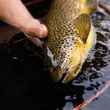







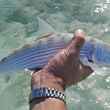



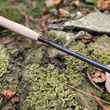


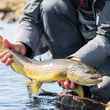


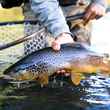

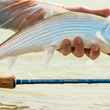

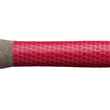
Comments
Bert Brehm replied on Permalink
"Rejection is the mind-killer. Rejection is the little-death that brings total obliteration. I will face my rejection."
Based on the teachings of the dry fly pantheon, here is my mantra:
1. Size
2. Profile
3. Color
Next problem...how to get a one-extra heavy hook to float?
Pages